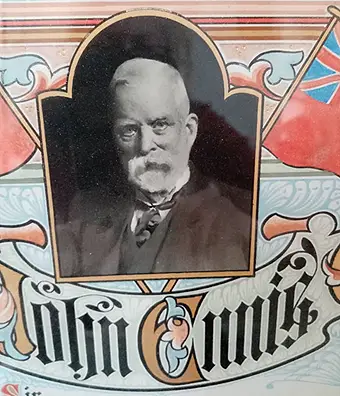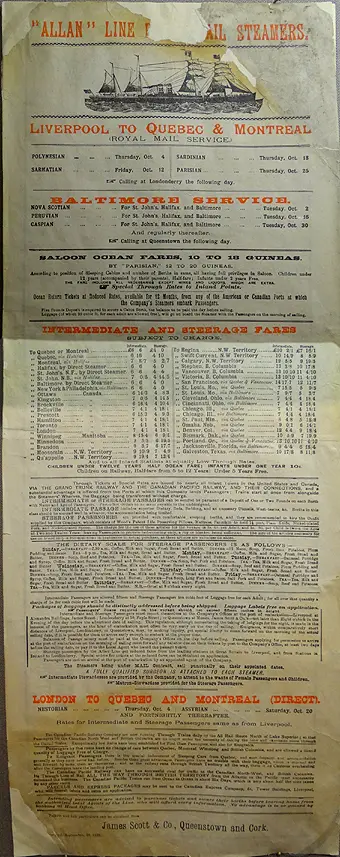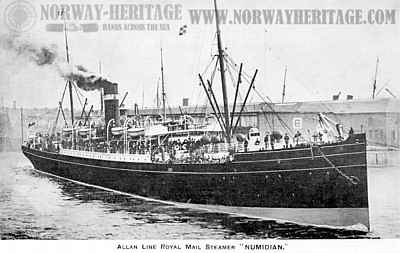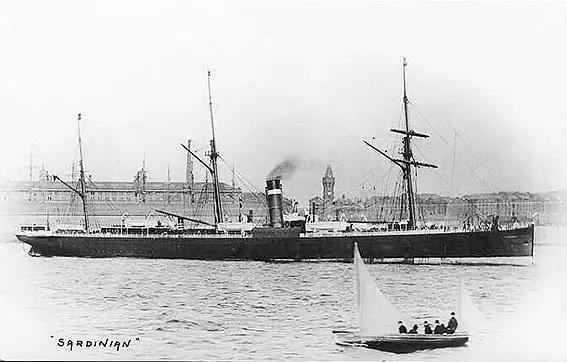Side Menu:
Chief Purser Hugh McElroy
- 1893 - 1898 Purser & First Ships

John Ellis of the Allan Line - seen here in a framed
presentation given to him for his retirement, July 1907.
(Courtesy of Joan O'Brien)
Hugh's father Richard had been in the Merchant Navy, but his choice of career was also influenced greatly by a family friend and future father-in-law, John Ellis, from County Wexford, the Passenger Manager of the Allan Line in Liverpool.
"Hugh then took the advice of family friend John Ennis, who was the passenger manager of the Allen Line passenger ship company and was hired by them, beginning his life’s work on ocean liners in 1892. Ennis got Hugh a job as a purser for the Allen Line, and put the line’s most experienced purser on his first trip on the R.M.S. Numidian to break him into the job." (Titanic Hero Hugh McElroy: 'Sand For Breakfast Tomorrow, The Wild Geese, by Joe Gannon)

Allan Line Royal Mail Steamers poster, circa 1890s.
Includes McElroy's the Sardinian. Heritage Centre in
Cobh, Ireland. Credit: Bjørn Christian Tørrissen
(Click to enlarge)
The Allan Shipping Line was started in 1819, by Captain Alexander Allan of Saltcoats, Ayrshire, trading and transporting between Scotland and Montreal.
McElroy's first ship, the R.M.S. Numidian was built in 1891 by D. & W. Henderson & Co. Ltd. in Meadowside, Glasgow, and was a British steel steamship with wo masts and one funnel. 400ft x 45.2ft, 4,836 gross and able to carry 1180 passengers (100 in first class, 80 in second class, and 1000 in third class). She made her maiden voyage as a passenger ship on the 20th August 1891 carrying passengers from Liverpool to Quebec, Montreal.
"Hugh went to sea for the first time in early 1893, as a Purser for the Allan Line on the R.M.S. Numidian, between Liverpool and Quebec, John Ellis must of thought highly of Hugh to put his Fleet’s Chief Purser with Hugh for his first voyage, to show him the rope’s and pitfalls, but Hugh was said to of taken to it like a fish to water, he continued for the next 7 years, to serve the Allen Line [sic] in the same capacity in other vessels of their fleet" (The Life and Times of Hugh Walter McElroy, Chief Purser of R.M.S. Titanic, by Frank McElroy).
The Role of the Purser
Technically speaking the role of a purser is "an official on a ship responsible for papers and accounts and on a passenger ship also for the comfort and welfare of passengers" (Merriam Webster). Specifically it comes under the steward's department, and a ship's purser (also known as a "pusser" but rarely used) reports directly to the captain and is responsible for handling money but by extension the officer responsible for all administration (including the ship's cargo and passenger manifests) and any other money-related needs of the passengers and crew. But as the Merriam Webster dictionary definition indicates it has also become synonymous with the "comfort and welfare of the passengers".
While not a deck officer in charge of the operation and navigation of the ship, the purser is indeed called an officer, with the connection dating back to when pursers joined the warrant officer ranks of the Royal Navy in the early 14th century and existed as a naval rank until 1852.
It is indeed a role of some importance - he is the head of the Victualling Department, which was usually the biggest department on an ocean liner.
The Allan Line

McElroy's first ship: the Numidian (Norway-Heritage).
The 4,800-ton Mongolian and Numidian (McElroy's first ship) were completed in 1891 to run as consorts to the Parisian, Sardinian and Circassian. The year 1891, when McElroy joined, marked the peak of the company's activities and for a short time the trans-Atlantic fleet consisted of no fewer than 37 ships, totalling 120,000 gross tons. Eight distinct services were being maintained during the summer months, namely: Liverpool-Quebec-Montreal (weekly); Liverpool-St. John's N.F.-Halifax-Baltimore (fortnightly); Glasgow- Quebec-Montreal (weekly); Glasgow-Boston (fortnightly); Glasgow-Halifax - Philadelphia (fortnightly); Glasgow-New York (weekly); Glasgow-Montevideo-Buenos Aires (monthly); London-Quebec-Montreal (fortnightly).
In addition, the Allan Line were agents for the Wilson-Hill Line between London and New York. No other British North Atlantic line, before or since, has provided anything like this variety of passenger services. Nevertheless it was obvious that drastic changes would soon be inevitable as practically half the ships in the fleet were 20 years old or more and several were over 30. (North Atlantic Seaway, by N.R.P Bonsor, courtesy of Henk Jungerius, https://www.shipsnostalgia.com/)
For the 7 years as purser at the Allan Line we presently only have mention of his first ship, the Numidian and his last ship the Sardinian (mentioned as his previous ship before joining White Stars in the Cymric's Particulars of Engagement in 1899). The SS Sardinian was constructed and launched in 1874 and completed the following year. She was 400 ft long, with a beam of 42 ft 3 in and a depth of19 ft 9 in. She had 1 x 2 cyl. Compound engine driving a single screw propeller and 3 Masts, and sailed mostly from Liverpool or Glasgow to different destinations in Canada like Montreal, Quebec and Halifax with some stopovers in the American cities of New York, Baltimore and Portland.

McElroy's last ship in the Allan Line - the Sardinian (Source: Old Ship Picture Galleries)
According to White Star documentation before entering service at White Star his years at sea were listed as "12 voyages... Seven years in Allan Line in Pursers Department". In the present absence of documentation we can only speculate as to which ships these were other than the Numidian and Sardinian - perhaps if he remained on the Canadian service the Numidian's sister ship the Mongolian, along with the Parisian and Circassian.